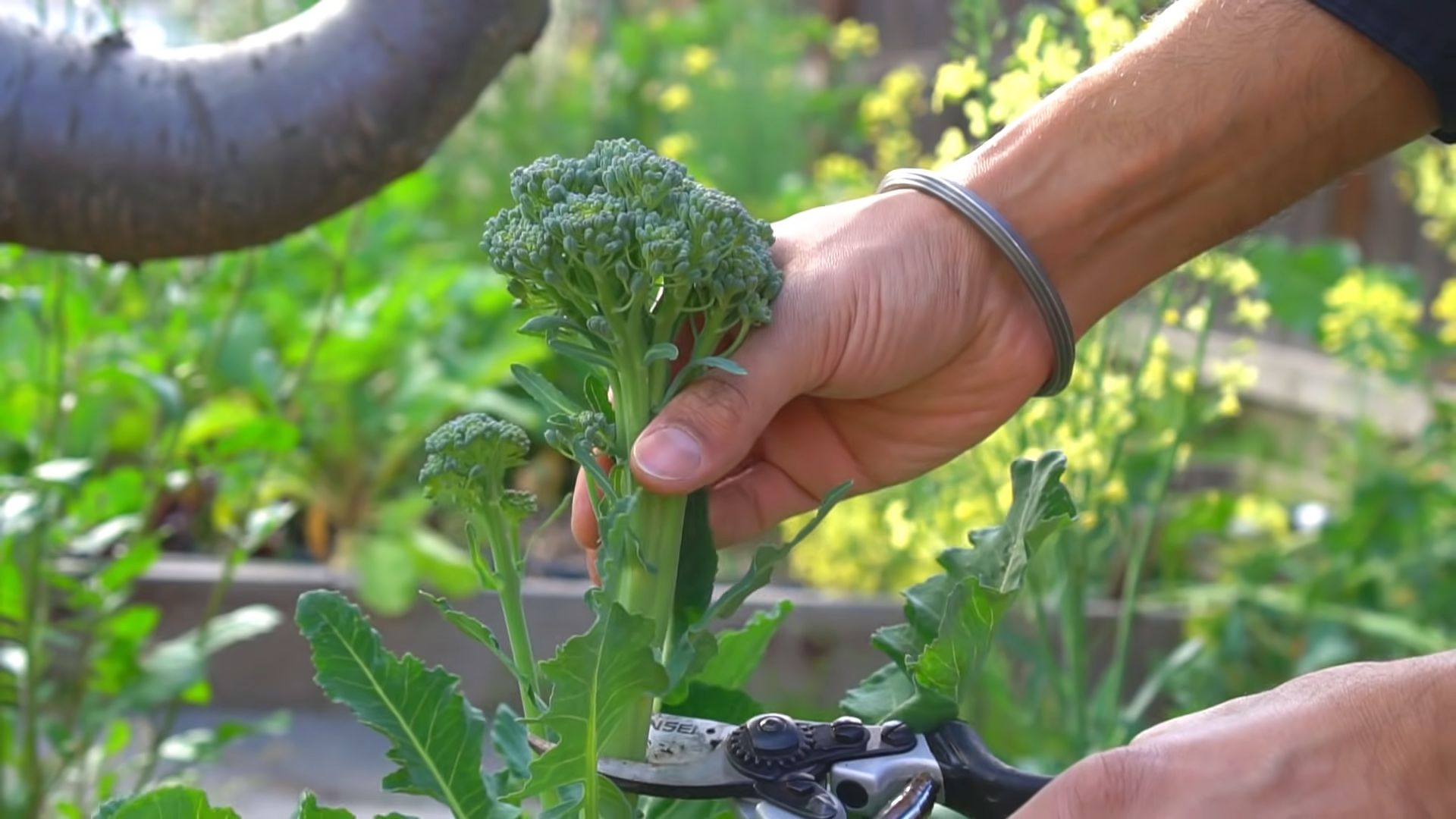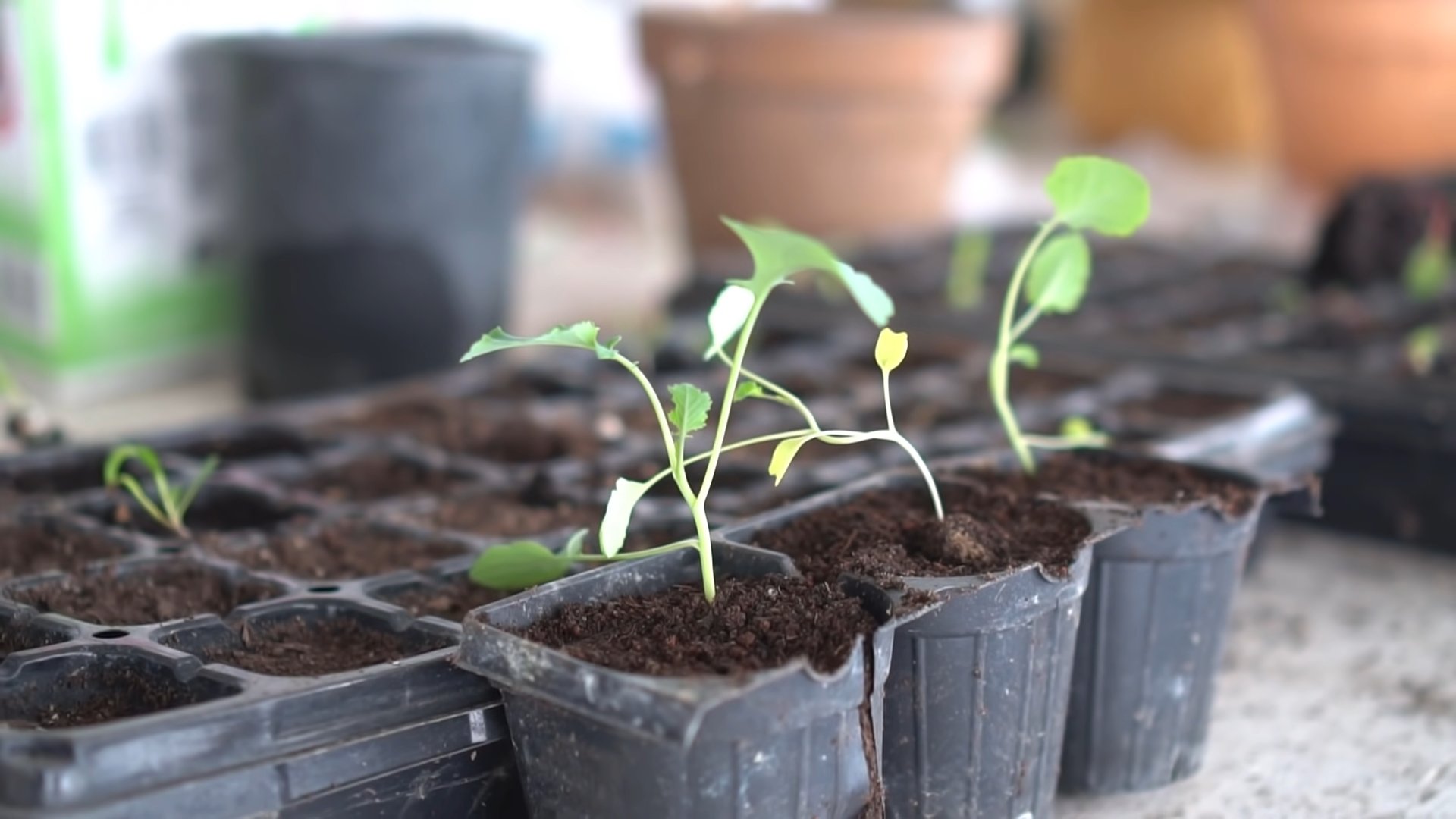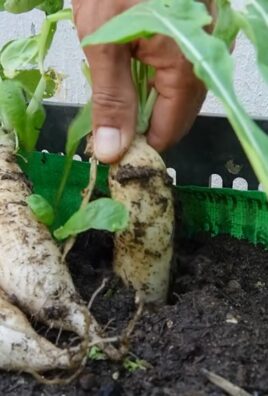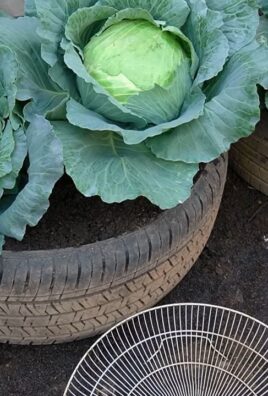Grow Broccoli at Home? Absolutely! Imagine stepping into your backyard and harvesting fresh, vibrant broccoli heads, ready to be steamed, roasted, or tossed into a delicious salad. It’s not just a dream; it’s an achievable reality with a few simple tricks and DIY techniques. For centuries, broccoli has been a nutritional powerhouse, cultivated from its wild cabbage ancestors in the Mediterranean. The Romans prized it, and now, you can too, right in your own backyard!
But why bother growing your own broccoli when you can buy it at the store? Well, for starters, homegrown broccoli tastes infinitely better! Plus, you control the growing process, ensuring it’s free from harmful pesticides and packed with nutrients. In this article, I’m going to share some easy-to-follow DIY hacks that will help you grow broccoli at home, even if you have limited space or gardening experience. We’ll cover everything from seed starting to pest control, ensuring you have a bountiful harvest. Get ready to unleash your inner gardener and enjoy the satisfaction of growing your own delicious and healthy broccoli!

Growing Broccoli at Home: A Beginner’s Guide
Hey there, fellow gardening enthusiasts! Ever thought about growing your own broccoli? It’s surprisingly easier than you might think, and the taste of homegrown broccoli is simply unbeatable. Plus, you’ll know exactly where your food is coming from and what’s gone into it. I’m going to walk you through everything you need to know to successfully grow broccoli in your own backyard (or even in containers!).
Choosing Your Broccoli Variety
First things first, let’s talk about broccoli varieties. There are tons of options out there, each with its own unique characteristics. Here are a few popular choices:
* ‘Waltham 29’: A classic, reliable variety that produces large, dark green heads. It’s known for its good flavor and heat tolerance.
* ‘DiCicco’: This variety is a bit faster to mature than ‘Waltham 29’ and produces smaller main heads, followed by plenty of side shoots. Perfect for a continuous harvest!
* ‘Green Magic’: As the name suggests, this variety produces beautiful, deep green heads. It’s also known for its excellent disease resistance.
* ‘ ক্যালব্রেস (Calabrese)’: This is the most common type of broccoli. It produces a large central head.
* ‘রোমানেস্কো (Romanesco)’: This is a unique looking broccoli with fractal spirals.
When choosing a variety, consider your local climate and growing season. Some varieties are better suited for warmer climates, while others are more cold-hardy. Also, think about how much space you have available. Some varieties can get quite large!
Starting Your Broccoli Seeds
You have two main options for starting your broccoli: direct sowing or starting seeds indoors. I personally prefer starting seeds indoors because it gives me a head start on the growing season and allows me to protect the seedlings from pests and harsh weather.
Here’s how to start your broccoli seeds indoors:
1. Gather your supplies: You’ll need seed starting trays or small pots, seed starting mix, broccoli seeds, a spray bottle, and a grow light (optional, but highly recommended).
2. Fill your trays or pots with seed starting mix: Gently moisten the mix with your spray bottle. You want it to be damp, but not soggy.
3. Sow your seeds: Plant 2-3 seeds per cell or pot, about 1/4 inch deep.
4. Cover the seeds with a thin layer of seed starting mix: Gently pat it down.
5. Water the seeds: Use your spray bottle to gently water the seeds.
6. Provide warmth and light: Place your trays or pots in a warm location (around 70-75°F) and under a grow light. If you don’t have a grow light, a sunny windowsill will work, but the seedlings may become leggy.
7. Keep the soil moist: Check the soil daily and water as needed to keep it moist.
8. Thin the seedlings: Once the seedlings have emerged and have a couple of true leaves (the second set of leaves), thin them to one seedling per cell or pot. Snip off the weaker seedlings at the soil line.
If you prefer to direct sow your broccoli seeds, wait until the soil has warmed up to at least 60°F. Sow the seeds about 1/2 inch deep and thin the seedlings to the strongest one per spacing.
Preparing Your Garden Bed
Broccoli needs a sunny spot with well-drained soil. Aim for at least 6 hours of sunlight per day. Before planting, it’s important to prepare your garden bed properly.
1. Clear the area: Remove any weeds, rocks, or debris from the area where you plan to plant your broccoli.
2. Amend the soil: Broccoli is a heavy feeder, so it needs nutrient-rich soil. Amend your soil with compost, aged manure, or other organic matter. This will improve drainage, fertility, and water retention.
3. Till the soil: Use a garden fork or tiller to loosen the soil to a depth of at least 12 inches. This will make it easier for the broccoli roots to grow.
4. Level the soil: Rake the soil to create a smooth, even surface.
Transplanting Your Broccoli Seedlings
Once your broccoli seedlings have 4-6 true leaves and are about 4-6 inches tall, they’re ready to be transplanted into your garden bed.
1. Harden off your seedlings: Before transplanting, you need to harden off your seedlings. This means gradually exposing them to outdoor conditions over a period of 7-10 days. Start by placing them outside in a sheltered location for a few hours each day, gradually increasing the amount of time they spend outdoors.
2. Choose a cloudy day: Transplanting on a cloudy day will help prevent the seedlings from getting stressed.
3. Dig holes: Dig holes that are slightly larger than the root balls of your seedlings. Space the holes about 18-24 inches apart.
4. Gently remove the seedlings from their trays or pots: Be careful not to damage the roots.
5. Place the seedlings in the holes: Make sure the top of the root ball is level with the surrounding soil.
6. Fill the holes with soil: Gently pat the soil around the seedlings.
7. Water the seedlings: Water thoroughly after transplanting.
Caring for Your Broccoli Plants
Once your broccoli plants are in the ground, it’s important to provide them with proper care to ensure a successful harvest.
* Watering: Broccoli needs consistent moisture, especially during hot, dry weather. Water deeply and regularly, aiming for about 1-2 inches of water per week.
* Fertilizing: Broccoli is a heavy feeder, so it needs regular fertilization. Fertilize every 2-3 weeks with a balanced fertilizer or a fertilizer specifically formulated for vegetables.
* Weeding: Keep the area around your broccoli plants free of weeds. Weeds compete with broccoli for nutrients and water.
* Mulching: Apply a layer of mulch around your broccoli plants to help retain moisture, suppress weeds, and regulate soil temperature.
* Pest control: Broccoli is susceptible to a variety of pests, including cabbage worms, aphids, and flea beetles. Inspect your plants regularly for signs of pests and take action as needed. You can use organic pest control methods, such as insecticidal soap or neem oil.
* Supporting: If your broccoli plants get very tall or the heads get very heavy, you may need to provide them with support. You can use stakes or cages to keep them from falling over.
Dealing with Common Broccoli Problems
Even with the best care, you may encounter some problems while growing broccoli. Here are a few common issues and how to deal with them:
* Cabbage worms: These green caterpillars can quickly devour broccoli leaves. Handpick them off the plants or use Bacillus thuringiensis (Bt), a natural insecticide.
* Aphids: These tiny insects suck the sap from broccoli leaves, causing them to curl and yellow. Spray the plants with insecticidal soap or neem oil.
* Flea beetles: These small, jumping beetles can create tiny holes in broccoli leaves. Cover the plants with row covers or spray them with neem oil.
* Clubroot: This fungal disease causes the roots of broccoli plants to swell and become distorted. Prevent clubroot by improving soil drainage and rotating your crops.
* Bolting: Bolting occurs when broccoli plants flower prematurely, usually due to hot weather. To prevent bolting, choose heat-tolerant varieties and provide shade during the hottest part of the day.
Harvesting Your Broccoli
The moment you’ve been waiting for! Knowing when to harvest your broccoli is key to getting the best flavor and texture.
1. Check the head: The broccoli head should be firm, compact, and dark green. The individual florets should be tightly closed.
2. Check the size: The size of the head will depend on the variety, but generally, you should harvest when the head is about 6-8 inches in diameter.
3. Cut the head: Use a sharp knife to cut the head from the plant, leaving about 6 inches of stem.
4. Harvest side shoots: After harvesting the main head, the plant will produce side shoots. These smaller heads can be harvested as they mature.
Extending Your Broccoli Harvest
Want to enjoy fresh broccoli for as long as possible? Here are a few tips for extending your harvest:
* Succession planting: Plant broccoli seeds every few weeks to ensure a continuous harvest.
* Choose bolt-resistant varieties: These varieties are less likely to bolt in hot weather.
* Provide shade: During the hottest part of the day, provide shade for your broccoli plants.
* Harvest regularly: Harvesting the main head will encourage the plant to produce more side shoots.

Conclusion
So, there you have it! Growing broccoli at home is not only achievable but also incredibly rewarding. Forget those bland, overpriced heads at the grocery store. Imagine stepping into your garden and harvesting crisp, vibrant, and intensely flavorful broccoli whenever you desire. This DIY approach puts you in complete control, from seed to table, ensuring you know exactly what’s going into your food – no hidden pesticides or questionable practices.
Why is this a must-try? Because it’s about more than just saving money (though that’s a definite perk!). It’s about connecting with nature, understanding the growing process, and experiencing the unparalleled satisfaction of nurturing your own food. Plus, homegrown broccoli simply tastes better. The freshness is undeniable, and the flavor is far superior to anything you can buy in a store.
But the benefits don’t stop there. Growing your own broccoli allows for experimentation and customization. Want to try a different variety? Go for it! Romanesco broccoli with its stunning fractal patterns? Absolutely! Prefer a smaller, more manageable plant? There are dwarf varieties perfect for container gardening. You can even adjust the planting schedule to stagger your harvests and enjoy fresh broccoli for an extended period.
Consider these variations to elevate your broccoli growing experience:
* Succession Planting: Plant new seeds every few weeks to ensure a continuous supply of broccoli throughout the growing season.
* Companion Planting: Plant beneficial herbs and flowers like dill, chamomile, and marigolds near your broccoli to deter pests and attract pollinators.
* Container Gardening: If you have limited space, grow broccoli in large containers on your patio or balcony. Choose a dwarf variety for best results.
* Broccoli Raab: Try growing broccoli raab, a leafy green with small florets that offers a slightly bitter, peppery flavor. It’s ready to harvest much sooner than traditional broccoli.
* Experiment with Varieties: Don’t be afraid to try different broccoli varieties, such as ‘Waltham 29’, ‘DiCicco’, or ‘Calabrese’, to find your favorite.
Growing broccoli at home is an investment in your health, your well-being, and your connection to the natural world. It’s a project that offers tangible rewards and a sense of accomplishment that’s hard to match.
So, what are you waiting for? Grab some seeds, prepare your soil, and embark on this exciting journey. We’re confident that you’ll be amazed by the results.
We encourage you to try this DIY trick and share your experience with us! Post photos of your homegrown broccoli on social media using #HomegrownBroccoli and tell us about your successes (and any challenges you encounter along the way). We’re eager to learn from your experiences and build a community of passionate home gardeners. Let’s cultivate a greener, healthier future, one broccoli plant at a time!
Frequently Asked Questions (FAQ)
1. What is the best time of year to plant broccoli?
The best time to plant broccoli depends on your climate. In cooler climates with mild summers, you can plant broccoli in early spring for a summer harvest and again in late summer for a fall harvest. In warmer climates with hot summers, it’s best to plant broccoli in late summer or early fall for a winter or early spring harvest. Avoid planting during the hottest months, as high temperatures can cause broccoli to bolt (go to seed prematurely). Check your local frost dates to determine the optimal planting times for your region. Generally, you want to start seeds indoors 6-8 weeks before the last expected frost in spring or 10-12 weeks before the first expected frost in fall.
2. What kind of soil does broccoli need?
Broccoli thrives in well-drained, fertile soil that is rich in organic matter. The ideal soil pH is between 6.0 and 7.0. Before planting, amend your soil with compost, aged manure, or other organic materials to improve drainage, fertility, and water retention. Broccoli is a heavy feeder, so it’s important to provide it with plenty of nutrients. Consider adding a slow-release fertilizer at planting time or side-dressing with compost tea or liquid fertilizer throughout the growing season. Avoid soils that are compacted or poorly drained, as these can lead to root rot and other problems.
3. How much sunlight does broccoli need?
Broccoli requires at least 6 hours of direct sunlight per day to grow properly. Choose a planting location that receives full sun for most of the day. If you live in a particularly hot climate, some afternoon shade may be beneficial to prevent the plants from overheating. Insufficient sunlight can result in leggy plants with small heads.
4. How often should I water broccoli?
Broccoli needs consistent moisture to thrive. Water deeply and regularly, especially during dry periods. Aim to keep the soil consistently moist but not waterlogged. A good rule of thumb is to water when the top inch of soil feels dry to the touch. Mulching around the plants can help to retain moisture and suppress weeds. Avoid overhead watering, as this can increase the risk of fungal diseases. Instead, water at the base of the plants using a soaker hose or drip irrigation system.
5. What are some common pests and diseases that affect broccoli, and how can I control them?
Broccoli is susceptible to several pests and diseases, including cabbage worms, aphids, flea beetles, clubroot, and downy mildew. To control pests, you can use row covers to protect young plants, handpick pests off the plants, or apply insecticidal soap or neem oil. To prevent diseases, choose disease-resistant varieties, practice crop rotation, and avoid overhead watering. Ensure good air circulation around the plants by spacing them properly. If you notice signs of disease, remove affected leaves promptly and apply a fungicide if necessary. Regularly inspect your plants for any signs of pests or diseases and take action promptly to prevent them from spreading.
6. How do I know when my broccoli is ready to harvest?
Broccoli is ready to harvest when the head is firm, tight, and the florets are still green and unopened. The size of the head will vary depending on the variety, but generally, you should harvest when the head is about 4-7 inches in diameter. Use a sharp knife to cut the head from the plant, leaving a few inches of stem. After harvesting the main head, the plant may produce smaller side shoots that can also be harvested. Harvest broccoli in the morning when the plants are cool and crisp.
7. Can I grow broccoli in containers?
Yes, you can grow broccoli in containers, but you’ll need to choose a large container (at least 5 gallons) and use a well-draining potting mix. Dwarf varieties of broccoli are best suited for container gardening. Be sure to provide the plants with plenty of sunlight, water, and fertilizer. Container-grown broccoli may require more frequent watering and fertilization than broccoli grown in the ground.
8. My broccoli plant is bolting (going to seed). What should I do?
Bolting is a common problem with broccoli, especially in hot weather. Once a broccoli plant bolts, the head will become loose and the florets will start to open and turn yellow. While you can still eat bolted broccoli, it will be more bitter and less tender. To prevent bolting, choose heat-tolerant varieties, plant at the right time of year, and provide adequate water and shade during hot weather. If your broccoli plant starts to bolt, harvest the head immediately to salvage what you can.
9. Can I eat the leaves of the broccoli plant?
Yes, the leaves of the broccoli plant are edible and nutritious. They have a slightly bitter, cabbage-like flavor and can be used in salads, stir-fries, or soups. Choose young, tender leaves for the best flavor. Avoid eating leaves that are discolored or damaged.
10. How do I store harvested broccoli?
Store harvested broccoli in the refrigerator in a plastic bag or container. Broccoli is best used within a few days of harvesting. To keep broccoli fresh for longer, you can blanch it for a few minutes in boiling water and then freeze it.




Leave a Comment